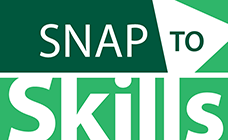Read the latest Policy Briefs produced by the SNAP to Skills Project providing policy and technical guidance to facilitate building effective job-driven SNAP E&T programs:
Come Together: Using Team-Based Case Management in SNAP E&T Review (July 2023)
Team-based case management is an innovative approach that removes redundancies and emphasizes coordination across the multiple organizations that may be serving the same participant. This brief describes how team-based case management can benefit SNAP E&T participants and provides an implementation checklist and resources for State agencies considering this approach. The brief includes promising examples from Kentucky, Vermont, and Washington, highlighting how each State used team-based case management during the 2014 Farm Bill E&T pilot projects.
SNAP E&T: Responding to the Employment and Training Needs of SNAP Participants Experiencing Homelessness and Housing Instability (August 2018)
Supplemental Nutrition Assistance Program Employment and Training (SNAP E&T) can be a critical part of States’ efforts to help SNAP participants secure the training and employment opportunities they need to reach economic self-sufficiency. The program’s flexibility to provide targeted employment and training services as well as robust supports can make it an effective tool for responding to the needs of SNAP participants that face high barriers to employment, including individuals experiencing homelessness or housing instability.
SNAP E&T and WIOA: Partnering to Raise Skills and Employment (June 2018)
SNAP E&T and State and local workforce agencies share a common goal of helping low-income individuals gain the skills necessary to qualify for jobs leading to self-sufficiency. A March 2016 joint letter issued by the Department of Agriculture’s Food and Nutrition Service (FNS) and the Department of Labor’s (DOL) Employment and Training Administration (ETA) encouraged SNAP and the workforce system to collaborate on shared strategies that connect SNAP participants to employment and training services through American Job Centers (AJCs). In particular, the letter emphasized ways to provide services to Able-Bodied Adults without Dependents (ABAWDs).
SNAP E&T Data Capture, Measurement & Reporting (May 2018)
More than ever, States need to improve their capacity to collect and report high quality data for their SNAP E&T programs. Such forces as new federal reporting requirements, an expanded focus on program accountability, and a growing number of third-party partnerships all create a need for more and better SNAP E&T outcome data. This brief addresses the following: 1) Why States should collect and analyze data; 2) What States must collect and what additional data they may find useful to collect; 3) What resources are available to States to support data collection and reporting; and 4) Examples of how States are capturing, measuring, and reporting data. The brief also includes examples of commonly used workforce development metrics and best practices for creating metrics.
Integrating SNAP E&T into Career Pathway Systems to Boost Outcomes (May 2017)
Career Pathways help people upgrade their skills and advance to better jobs over time through a stackable set of education and training steps and credentials within a particular industry. The sixth SNAP to Skills brief highlights how, as States expand and improve Supplemental Nutrition Assistance Program Employment and Training (SNAP E&T) services, they can consider incorporating SNAP E&T into existing career pathways systems to get better results for participants.
Building an Employer-Driven SNAP E&T Program by Utilizing Labor Market Information (April 2017)
Employer-driven SNAP E&T programs offer participants the best opportunities to secure good jobs leading to economic self-sufficiency while responding directly to the needs of local industries and employers. The fourth SNAP to Skills policy brief explores how labor market information (LMI) is used to design employer-driven training programs and ensure training pathways to "good" jobs.
Building State Capacity to Support Expanded SNAP E&T Programs (November 2016)
In this brief, the SNAP to Skills Project seeks to reduce State uncertainty about the staffing and infrastructure needed to support SNAP E&T program growth. The brief explores key tasks, roles, and systems and offers recommendations for identifying and accessing the resources they may need to support this added capacity.
Securing Third-Party Partners for SNAP E&T Programs (July 2016)
Third-party partners, such as community-based organizations, community colleges, and others, are critical to building and growing a robust SNAP E&T Program. The third S2S project brief provides a high-level understanding of the steps involved in building a third-party partnership.
Using SNAP E&T to Offer Job-Driven Training for Able-Bodied Adults without Dependents (ABAWDs) (May 2016)
As State ABAWD waivers expire and the 3-month time limit goes into effect, the second S2S Project brief explores the potential and limits of SNAP E&T in responding to the needs of ABAWDs.
Why Now is the Time for States to Build their SNAP E&T Programs (April 2016)
This first brief from the SNAP to Skills Project provides an overview of the important role of SNAP E&T, describes program basics, presents ideas for States to jumpstart their programs, and summarizes the work of SNAP to Skills.


